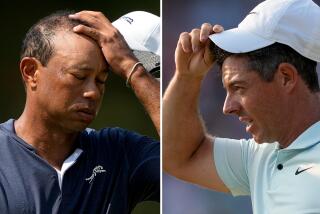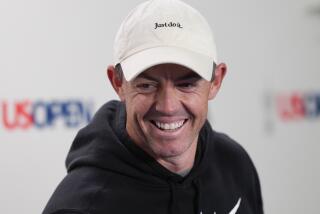Newest McEnroe: For Real This Time?
WASHINGTON — A curious on-court incident Tuesday night at the Sovran Bank Classic triggered a reflection from John McEnroe, tennis virtuoso of past and perhaps future years, about the origins of John McEnroe, tennis fiend.
McEnroe was in the process of routing Paul Chamberlin in straight sets when a blatantly bad line call was made against him. He protested, albeit relatively mildly, until Chamberlin did the virtually unthinkable: He renounced the point and gave it to McEnroe.
“The call was obviously wrong,” Chamberlin said later. “It was the fair thing to do.” McEnroe applauded the gesture, but also thought back to 1977, when, as a tour newcomer still acclimated to the juniors’ practice of players monitoring the lines themselves, he gave back a handful of calls in a match against veteran Phil Dent.
As they sat next to one another at a changeover, McEnroe recalled, Dent told him: “You don’t do that in the pros, kid. Play the calls the way they make ‘em.” On his march to the Wimbledon semifinals later that year, McEnroe remembered what Dent had said, only he took the advice a few steps further, and each questionable ruling became a signal for a fiery, name-calling performance. The ranting, raving, tempestuous McEnroe made his debut. As McEnroe said: “John McEnroe was born.”
He would become the best and worst the game had to offer, all wrapped into a single package. He was tennis’s supreme artist for the better part of a decade, finishing with the No. 1 ranking four straight years, 1981-84. He won three Wimbledons and four U.S. Opens, and he could do almost anything he pleased with a tennis racket -- from overwhelming opponents with serve-and-volley assaults to beguiling them at the baseline with the deftness of his touch.
But the stormy, abusive behavior that accompanied McEnroe’s brilliant play offended many. He was loved and hated by fans and other players with equal doses of passion. Always, he elicited a reaction, but the response became increasingly negative as the bad-boy antics grew wearisome.
The blunt, aggressive New York personality remains in the McEnroe of 1990, although it’s softened around the edges. Missing, however, is the ability to dominate anyone he wants, anywhere, at any time he desires. The McEnroe on display here this week is the world’s 12th-ranked player, a volatile mix of talent and uncertainties trying to avoid the status of relic.
He has pledged himself to the latest in a series of rededications to the game after more than three years of wavering commitment and comparatively subpar results. He has returned to the coach who taught him how to play when he was 11 years old, and he has taken up a training regimen of running and weightlifting.
He proclaims he can get back to his place atop the tennis world, or at least very close to it. And, perhaps most tellingly, he apparently is indifferent as to whether anyone else thinks he can do so.
“I don’t care if you believe me,” McEnroe said at his postmatch news conference Tuesday. “In fact, I hope you bury me. That will only make it that much more rewarding when I do it. I’d prefer to be written off now.
There certainly is plenty of room for improvement. McEnroe, at 31 the oldest player in this tournament, has been decidedly ordinary this year. He was defaulted for an outburst during the Australian Open in January while leading Mikael Pernfors, two sets to one, then lost in the semifinals of tournaments in Milan and Toronto to Tim Mayotte and Ivan Lendl, respectively.
The slide has accelerated, though. He lost to Richey Reneberg, a promising but raw American, in a round-of-32 match in Philadelphia. He is playing here in just his third tournament since February, having lost to Lendl in straight sets in the semifinals in the Queens tournament and to Derrick Rostagno in the opening round at Wimbledon. His 1990 singles record is 13-6.
He refuses to call the straight-sets defeat to the 113th-ranked Rostagno the low point of his career, but it definitely served as a signal. McEnroe’s training program before the Rostagno match consisted mostly of some sporadic hitting sessions, and the lack of preparation showed.
The loss prompted McEnroe to declare his recommitment to tennis once more. It has been a familiar refrain for him since he took the first of a succession of sabbaticals from the game in 1986. He left, he returned, he promised to be the McEnroe of old. Over and over it has gone.
Last year was a good one for him as he won three Grand Prix titles and almost $950,000. He made the Wimbledon semifinals and climbed to No. 4 in the rankings.
His priorities had shifted. He’s a family man, with wife Tatum O’Neal and two sons. He has a plethora of endorsement contracts, including a lucrative deal with Nike, and he was finding that being a celebrity could be a full-time task. “Other things become important,” he said.
Said Chamberlin, who became a father 11 months ago: “I used to hear John say that your priorities change, and I never understood what he was talking about until I had a family of my own. You want to be a good father. You try to balance the two, but it’s difficult and your tennis ends up losing out.”
But McEnroe and his coach, Tony Palafox, contend this comeback bid is the real thing. After Wimbledon, McEnroe contacted Palafox, who has guided him off and on since McEnroe’s mother first brought her son to Palafox’s Long Island tennis academy 20 years ago.
Palafox said he wasn’t sure what he had then, when he put the skinny youngster into the third of three skill-level groups-and the feeling occasionally has repeated itself since. The two have been a team through good times and bad, with McEnroe coming to his old mentor when he feels the greatest need. Palafox said he believes prosperity is on the horizon again.
“This is the most serious he’s been” about revitalizing his career, Palafox said by telephone Wednesday. “He knows if he doesn’t do it now, he’ll have failed at something. He doesn’t like to fail, and he’s never really done it. ... He’s hungry. He wants to train, and he wants to get back to where he was.”
There are skeptics. Mayotte said after beating him that McEnroe’s shots lacked their one-time sting, and Chamberlin observed: “I definitely see some signs in his game that it’s not coming around for him.”
McEnroe ignores the naysayers. He has his supporters, too. “I’d like to see him do well,” Andre Agassi, the Sovran’s top seed, said Wednesday. “It would be great for the sport. But it seems like he’s dealing with a lot more than just tennis rackets and tennis balls.”
For now, McEnroe just wants to play matches. He still is searching for the racket and style that suits him best. His place in history is secure, given his 75 singles titles and more than $11 million in prize money. But he wants to have it all again.
“I’m eager,” McEnroe said. “I’m ready to do it, even if it means losing to the Rostagnos. ... There’s no doubt in my mind I can beat the best players in the world again. I’m sure they’d have something to say about that, but again, I don’t really care what anyone says.”
And, finally, what did he think when Chamberlin gave him the point Tuesday? “I thought it was one of two things,” McEnroe said. “One, he’s trying to pull some reverse-psychology thing on me. Or two, he’s just done something good for the game of tennis.
“I prefer to believe the second. I want to be a positive thinker.”
More to Read
Go beyond the scoreboard
Get the latest on L.A.'s teams in the daily Sports Report newsletter.
You may occasionally receive promotional content from the Los Angeles Times.










